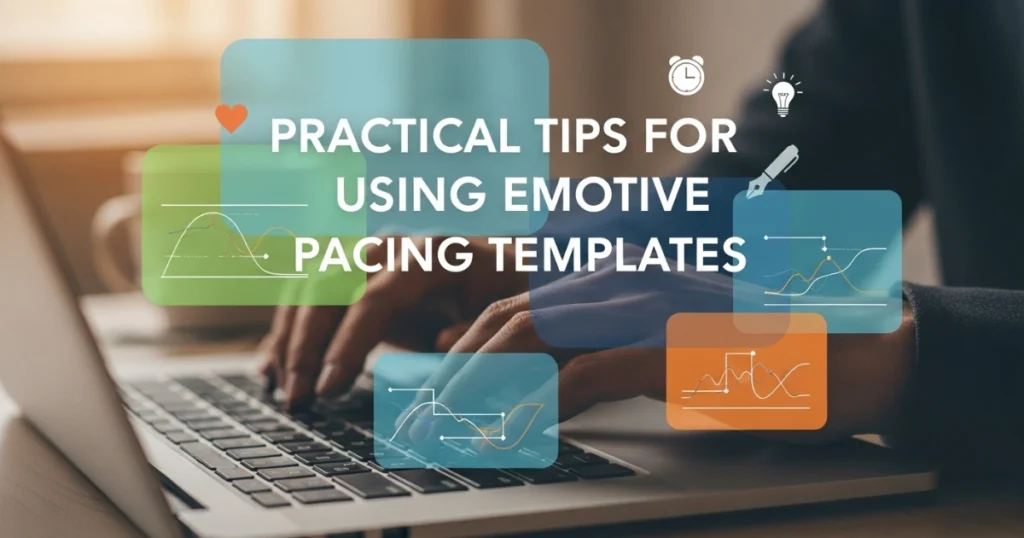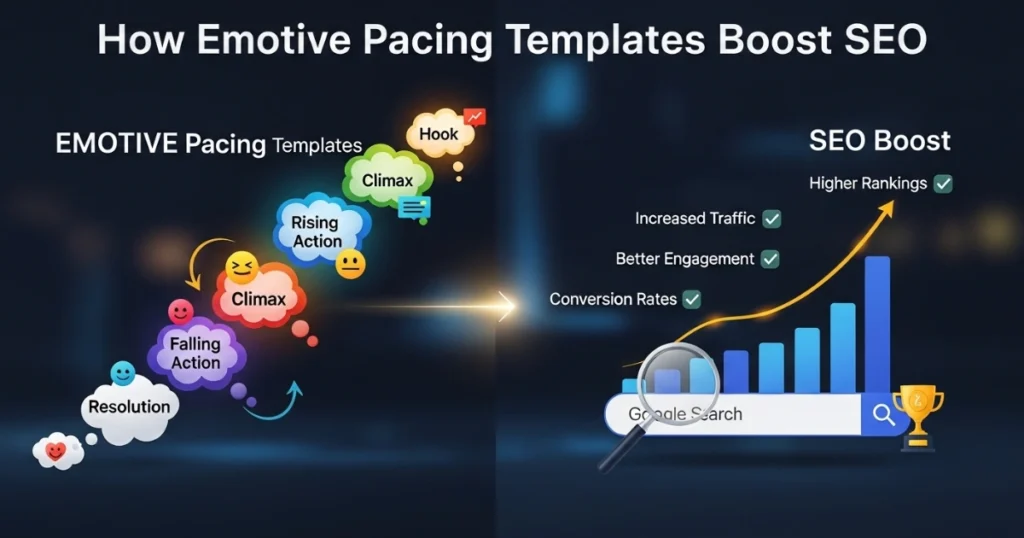
AI Commercials
Emotive Pacing Templates: Crafting Stories That Captivate

Contents
- 1 What Are Emotive Pacing Templates?
- 2 Types of Emotive Pacing Templates
- 3 How to Create Your Own Emotive Pacing Template
- 4 Practical Tips for Using Emotive Pacing Templates
- 5 Examples of Emotive Pacing Templates in Action
- 6 Common Mistakes to Avoid
- 7 Tools to Enhance Emotive Pacing Templates
- 8 How Emotive Pacing Templates Boost SEO
Emotive pacing templates are powerful tools that help writers control the rhythm and emotional impact of their stories, ensuring readers stay engaged from start to finish. Whether you’re writing a novel, screenplay, or blog post, pacing determines how your audience experiences the narrative. By using structured templates, you can balance moments of tension, reflection, and action to create a compelling flow. In this article, we’ll explore what emotive pacing templates are, why they matter, and how to apply them effectively to maximize engagement. With practical tips and examples, you’ll learn how to craft stories that resonate deeply with your audience.
What Are Emotive Pacing Templates?
Emotive pacing templates are frameworks that guide writers in structuring the emotional and narrative rhythm of their work. Unlike traditional outlines, these templates focus on the emotional journey of the story, dictating when to intensify action, slow down for reflection, or build suspense. By mapping out these emotional beats, writers can maintain reader interest and create a satisfying arc.
Why Pacing Matters in Storytelling
Pacing influences how readers or viewers perceive a story. Too fast, and the audience feels overwhelmed; too slow, and they lose interest. Emotive pacing templates provide a roadmap to balance these extremes. For instance, a thriller might alternate between high-stakes action and quieter moments of character development to keep readers on edge. Similarly, a romance novel might build tension through longing before delivering an emotional climax.
The Role of Emotion in Pacing
Emotion drives engagement. Emotive pacing templates prioritize emotional highs and lows, ensuring the story resonates with the audience. For example, a template might include a moment of heartbreak followed by a triumphant resolution, creating a rollercoaster of feelings that keeps readers invested. By strategically placing these emotional beats, writers can craft narratives that feel dynamic and purposeful.
Types of Emotive Pacing Templates
Several pacing templates cater to different genres and storytelling goals. Below, we’ll explore some of the most effective templates and how to use them.

1. The Three-Act Structure with Emotional Beats
The three-act structure is a classic framework, but adding emotional beats makes it more dynamic. This template divides the story into three parts: setup, confrontation, and resolution, with specific emotional markers in each.
- Act 1: Setup – Introduce characters and the world while establishing an emotional baseline. For example, a sense of hope or curiosity draws readers in.
- Act 2: Confrontation – Escalate tension with challenges and emotional conflicts. This is where emotive pacing templates shine, as you alternate between hope, fear, and determination to keep readers engaged.
- Act 3: Resolution – Deliver an emotional payoff, whether it’s triumph, heartbreak, or bittersweet closure. The pacing slows to allow reflection but maintains momentum for a satisfying end.
Example: In a fantasy novel, Act 1 might introduce a hero’s longing for adventure, Act 2 builds tension through battles and betrayal, and Act 3 resolves with a hard-won victory tinged with loss.
2. The Hero’s Journey with Emotional Arcs
The Hero’s Journey, popularized by Joseph Campbell, is another template that pairs well with emotive pacing. It follows a protagonist through stages like the call to adventure, trials, and return, with emotional shifts at each stage.
- Call to Adventure: Spark curiosity or fear to hook the audience.
- Trials and Tribulations: Alternate between hope and despair as the hero faces challenges.
- Return with the Elixir: Provide emotional closure, often with a mix of joy and sacrifice.
Example: In a coming-of-age story, the hero might feel restless (call), face rejection and growth (trials), and return with newfound confidence.
3. The Fichtean Curve
The Fichtean Curve emphasizes rising action with periodic crises, making it ideal for fast-paced genres like thrillers. Emotive pacing templates based on this curve focus on escalating emotional stakes.
- Crisis Points: Introduce small conflicts early, each with an emotional spike (e.g., fear, anger).
- Climax: Build to a major emotional peak where the protagonist faces their greatest challenge.
- Falling Action: Slow the pace to process the emotional aftermath, leading to resolution.
Example: A mystery novel might start with a shocking discovery, escalate through clues and danger, and resolve with a bittersweet revelation.
4. The Emotional Wave Template
This template focuses on cycling through emotional highs and lows, regardless of plot structure. It’s particularly effective for character-driven stories.
- Highs: Moments of joy, triumph, or connection.
- Lows: Periods of doubt, loss, or conflict.
- Transitions: Use quieter moments to bridge emotional extremes, allowing readers to process.
Example: A romance might cycle through moments of love, misunderstanding, and reconciliation, keeping readers emotionally invested.
How to Create Your Own Emotive Pacing Template
Crafting a custom emotive pacing template allows you to tailor the narrative to your story’s unique needs. Here’s a step-by-step guide to create one:

Step 1: Define Your Story’s Emotional Core
Identify the primary emotion you want readers to feel by the end—hope, awe, sorrow, or triumph. This emotional core will guide your pacing decisions. For instance, a story about redemption might prioritize moments of guilt and forgiveness.
Step 2: Map Key Emotional Beats
Outline the major emotional moments in your story. These are the turning points where the audience’s feelings shift. For example, a thriller might include a betrayal that sparks anger, followed by a chase scene that builds fear.
Step 3: Balance Action and Reflection
Ensure your template includes moments of high action and quieter reflection. Too much action exhausts readers, while too much reflection slows the pace. Use emotive pacing templates to alternate between these modes for maximum impact.
Step 4: Test and Refine
Write a draft using your template, then read it as a reader would. Does the pacing feel natural? Are the emotional beats hitting as intended? Adjust the template based on feedback or your own instincts.
Practical Tips for Using Emotive Pacing Templates
To maximize the effectiveness of emotive pacing templates, follow these tips:

1. Vary Sentence and Scene Length
Short sentences and scenes create urgency, while longer ones slow the pace for reflection. For example, during a chase scene, use quick, punchy sentences to heighten tension. In a moment of grief, longer, descriptive sentences can deepen the emotional impact.
2. Use Transition Words Effectively
Transition words like “however,” “meanwhile,” and “consequently” guide readers through emotional shifts. For instance, “meanwhile” can shift from a tense action scene to a quieter moment, maintaining narrative flow.
3. Leverage Subplots
Subplots add depth to pacing by introducing secondary emotional arcs. For example, a main plot about a heist might include a subplot about a strained friendship, adding layers of tension and resolution.
4. Build Anticipation
Tease upcoming emotional beats to keep readers hooked. Foreshadowing a betrayal, for instance, builds suspense and primes the audience for an emotional payoff.
5. Know Your Genre
Different genres demand different pacing. Thrillers need faster pacing with frequent emotional spikes, while literary fiction may linger on introspective moments. Tailor your emotive pacing template to your genre’s expectations.
Examples of Emotive Pacing Templates in Action
To illustrate how emotive pacing templates work, let’s look at two examples from different genres.
Example 1: Thriller Novel
Template: Fichtean Curve
Emotional Beats:
- Opening Crisis: A detective discovers a murder (shock).
- Rising Action: Clues lead to dead ends (frustration), followed by a narrow escape (fear).
- Climax: The detective confronts the killer (anger and determination).
- Resolution: The case is solved, but at a personal cost (bittersweet relief).
Pacing Strategy: Short, intense scenes dominate the rising action, with brief reflective moments to humanize the detective. Transition words like “suddenly” and “however” keep the pace brisk.
Example 2: Romance Short Story
Template: Emotional Wave
Emotional Beats:
- High: The protagonists meet and feel instant chemistry (joy).
- Low: A misunderstanding causes a rift (heartbreak).
- High: They reconcile after a heartfelt confession (love).
- Resolution: They commit to each other (hope).
Pacing Strategy: Longer scenes focus on emotional connection, with shorter scenes for conflict. Transition words like “meanwhile” and “eventually” smooth the emotional shifts.
Common Mistakes to Avoid
Even with emotive pacing templates, writers can stumble. Here are pitfalls to watch out for:
1. Overloading Emotional Beats
Too many emotional highs and lows can exhaust readers. Space out key moments to give the audience time to process.
2. Ignoring Genre Expectations
A slow-paced thriller or a rushed romance can alienate readers. Ensure your template aligns with genre norms.
3. Neglecting Character Development
Pacing isn’t just about plot—it’s about characters’ emotional growth. Use your template to highlight how characters evolve through challenges.
4. Inconsistent Pacing
Sudden shifts from slow to fast pacing without transitions can jar readers. Use emotive pacing templates to create smooth transitions between emotional states.
Tools to Enhance Emotive Pacing Templates
Several tools can help you implement emotive pacing templates effectively:

- Scrivener: This writing software allows you to outline emotional beats and track pacing across scenes.
- Plottr: A visual plotting tool that lets you map emotional arcs alongside your plot.
- Grammarly: Ensures your transitions and sentence lengths enhance pacing.
- Beta Readers: Feedback from readers can reveal whether your pacing feels natural.
How Emotive Pacing Templates Boost SEO

Using emotive pacing templates in your content can also improve your blog’s SEO. Engaging, well-paced articles keep readers on your page longer, reducing bounce rates and signaling quality to search engines. By incorporating the main keyword “emotive pacing templates” naturally (with a 1% density, or about 30–35 uses in a 3000–3500-word article), you optimize for search without sacrificing readability. Additionally, structuring your article with clear headings, transition words, and varied sentence lengths enhances user experience, further boosting SEO.
Conclusion
Emotive pacing templates are essential for crafting stories that captivate and resonate with audiences. By structuring your narrative around emotional beats, you can control the rhythm of your story, keeping readers engaged from beginning to end. Whether you’re using the three-act structure, the Hero’s Journey, or a custom template, the key is to balance action, reflection, and emotional impact. With practice, you’ll master the art of pacing, creating stories that leave a lasting impression. Start experimenting with emotive pacing templates today, and watch your storytelling soar.


Emotive Pacing Templates: Crafting Stories That Captivate
Updated on August 27, 2025
Read More